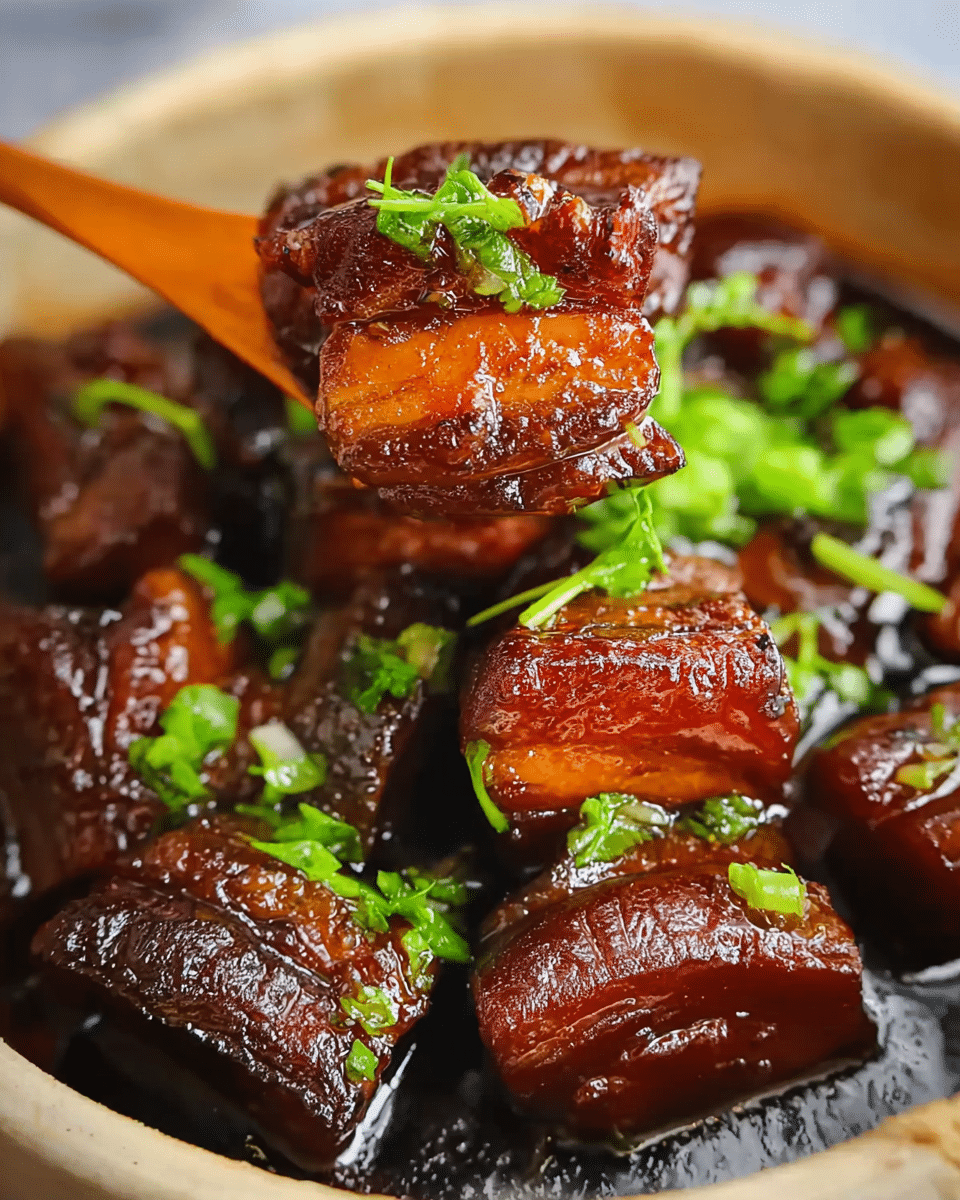Hong Shao Rou, or Red Braised Pork Belly, is a classic Chinese dish where pork belly is slowly braised in a rich, savory sauce until tender and flavorful. This version of Hong Shao Rou features abalone, adding a luxurious touch to the dish. The pork belly is cooked in a combination of dark soy sauce, light soy sauce, Shaoxing wine, and rock candy, resulting in a glossy, deeply flavorful sauce. Perfect for special occasions or a hearty dinner, this dish is a delicious introduction to Chinese braised meats.
Full Recipe:
Ingredients
-
2 lb pork belly
-
1 tbsp vegetable oil
-
4 slices ginger
-
2 green onions
-
3 tbsp Shaoxing cooking wine
-
1 tbsp dark soy sauce
-
3 tbsp light soy sauce
-
¼ cup rock candies (about 40g), or brown sugar if unavailable
-
Hot water
-
6-8 abalone (optional)
Directions
-
Prepare the Pork Belly:
Cut the pork belly into 2-inch cubes and soak in cold water for 30 minutes. Drain and pat dry with paper towels. -
Pan-Fry the Pork Belly:
Heat vegetable oil in a large frying pan over medium heat. Add the pork belly cubes and sear until golden brown on all sides, avoiding the skin side to prevent splattering. -
Braise the Pork Belly:
Transfer the seared pork to a Dutch oven. Add ginger, green onions, cooking wine, dark soy sauce, light soy sauce, rock candies, and hot water until the liquid barely covers the pork. Bring to a boil, then reduce heat to low and simmer for 1 hour, covered. -
Optional: Add Abalone:
If using abalone, clean and slice them, then add them to the pot after 1 hour of simmering. Let them cook in the sauce for an additional 10 minutes. Skip this step if not using abalone. -
Thicken the Sauce:
Once the pork is tender, remove the lid and increase heat to medium. Stir continuously to thicken the sauce to your desired consistency. -
Serve:
Transfer the pork belly and abalone (if used) to a serving plate, garnish with chopped green onions, and drizzle with the remaining sauce. Serve hot with steamed rice and vegetables.
Tips for Making Hong Shao Rou
-
Choice of Pork Belly:
Select a pork belly with a good balance of meat and fat, preferably with three layers of lean meat and three layers of fat for optimal texture and flavor. -
Cooking Time:
Ensure that you don’t overcook the pork belly to maintain its tender, melt-in-your-mouth texture. If using abalone, add it at the end to prevent overcooking. -
Soy Sauce Combination:
Use both dark and light soy sauce for a rich, balanced flavor. If needed, you can substitute dark soy sauce with more light soy sauce, though this will alter the dish’s color and flavor. -
Serving:
For a more authentic presentation, serve this dish with steamed rice and a side of vegetables to balance the richness of the pork belly.
Nutrients
-
Calories: 400 kcal
-
Carbohydrates: 12g
-
Protein: 25g
-
Fat: 30g
-
Saturated Fat: 10g
-
Cholesterol: 70mg
-
Sodium: 800mg
-
Potassium: 250mg
-
Fiber: 1g
-
Sugar: 6g
The Richness of Pork Belly in Hong Shao Rou
Pork belly is the star ingredient in Hong Shao Rou, and for good reason. The meat-to-fat ratio in pork belly is ideal for braising, as the fat renders down during the cooking process, infusing the meat with flavor and creating a tender, juicy texture. When braised slowly, the layers of fat and meat break down and absorb the rich sauce, resulting in a melt-in-your-mouth consistency that is both satisfying and indulgent.
For the best results, it is important to choose a pork belly with a good balance of fat and meat. Ideally, the pork belly should have layers of lean meat alternating with fat. This layering allows the dish to achieve the perfect balance between the richness of the fat and the savory flavor of the meat. The fat in the pork belly also helps the dish retain moisture, ensuring that the meat stays tender throughout the braising process.
The Savory Sauce: A Blend of Soy Sauce, Shaoxing Wine, and Rock Candy
The sauce that accompanies Hong Shao Rou is what truly defines the dish. It is a complex blend of dark soy sauce, light soy sauce, Shaoxing wine, and rock candy, which together create a rich, glossy, and flavorful glaze that coats the pork belly as it cooks. Dark soy sauce provides depth and a slightly sweet undertone, while light soy sauce adds a savory, salty balance. Shaoxing wine, a traditional Chinese rice wine, adds a touch of complexity and aromatic fragrance that complements the other ingredients.
Rock candy, often used in Chinese braising recipes, brings a subtle sweetness to the sauce, helping to round out the savory flavors. It also contributes to the beautiful, deep amber color of the braise. If rock candy is unavailable, brown sugar can be used as a substitute, though it may slightly alter the flavor profile. The sugar in the sauce helps to caramelize the meat, creating that signature glossy sheen that is characteristic of Hong Shao Rou.
The combination of these ingredients results in a sauce that is simultaneously savory, sweet, and slightly aromatic, creating a perfect complement to the rich pork belly. As the pork belly simmers in the sauce, it absorbs all of these flavors, resulting in a deeply flavorful and satisfying dish.
The Luxury of Abalone: A Special Touch
In this variation of Hong Shao Rou, abalone is added to elevate the dish and give it a luxurious touch. Abalone is a prized seafood, known for its delicate texture and subtle sweetness. When added to the braise, the abalone absorbs the rich sauce, adding another layer of flavor and luxury to the dish. The soft, tender abalone pairs wonderfully with the rich, savory pork belly, creating a perfect balance between land and sea.
Abalone should be added toward the end of the cooking process to prevent it from overcooking and becoming tough. A brief simmer in the braising liquid is all that is needed to infuse the abalone with the flavors of the sauce, while still maintaining its delicate texture. The inclusion of abalone is optional, but it adds an extra layer of sophistication and is perfect for special occasions or when you want to treat yourself to something truly extraordinary.
Braising: The Art of Slow-Cooked Perfection
The process of braising is key to achieving the tender, melt-in-your-mouth texture of Hong Shao Rou. Braising is a slow-cooking method where the meat is simmered in a flavorful liquid over low heat for an extended period of time. This allows the meat to break down and absorb the flavors of the sauce, while also rendering out the fat, resulting in a moist and tender dish.
For the best results, it is important to braise the pork belly slowly and at a low temperature. High heat can cause the meat to toughen, while slow cooking ensures that the pork belly becomes tender and succulent. During the braising process, the sauce should be monitored and adjusted as needed to ensure that it does not become too thick or too thin. If necessary, a little water can be added to maintain the right consistency, but it is important to avoid diluting the flavors of the sauce.
Thickening the Sauce: Achieving the Perfect Consistency
Once the pork belly has become tender and the flavors have melded together, the next step is to thicken the sauce. This is typically done by increasing the heat and allowing the braising liquid to reduce, intensifying the flavors and achieving a glossy, thick consistency. The reduction process also helps to concentrate the savory and sweet flavors in the sauce, creating a rich glaze that coats the pork belly and enhances the overall dish.
It is important to stir the sauce occasionally during the reduction process to prevent it from burning. The sauce should be thick enough to coat the back of a spoon but not so thick that it becomes syrupy. The goal is to achieve a luxurious glaze that will cling to the pork belly and abalone, creating a glossy, flavorful finish that adds to the dish’s appeal.
Serving Hong Shao Rou: A Feast for the Eyes and the Palate
Hong Shao Rou is a visually stunning dish that is perfect for special occasions. The glossy, caramelized pork belly and the luxurious abalone (if used) make for an impressive presentation. When serving, the dish is often garnished with freshly chopped green onions to add a pop of color and a touch of freshness that contrasts with the richness of the braised pork belly.
This dish is best served with steamed rice, which helps to balance the richness of the pork belly and absorb the flavorful sauce. A side of sautéed or steamed vegetables, such as bok choy or Chinese broccoli, can also complement the dish, providing a refreshing contrast to the hearty pork belly.
Conclusion: A Delicious and Luxurious Dish
In conclusion, Hong Shao Rou with abalone is a luxurious and deeply flavorful dish that showcases the best of Chinese braised meats. The combination of tender pork belly, a rich braising sauce, and the delicate addition of abalone creates a dish that is both indulgent and satisfying. Whether you’re celebrating a special occasion or simply looking for a hearty and comforting meal, this dish offers a perfect balance of flavors and textures that will delight your guests and leave them wanting more.
The slow braising process ensures that the pork belly becomes tender and flavorful, while the sauce, made from a blend of soy sauce, Shaoxing wine, and rock candy, imparts a deep, savory sweetness that complements the richness of the meat. The optional addition of abalone elevates the dish to new heights, adding a luxurious touch that makes it perfect for those looking to indulge. Hong Shao Rou is a true Chinese classic that brings together rich flavors, tender meat, and a touch of luxury, making it a dish that is sure to impress every time.






